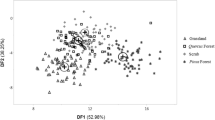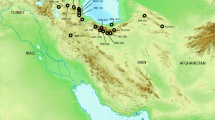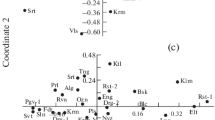Abstract
Jatropha spp. from Mexico includes high species richness and endemism; five species inhabit in the Tehuacan-Cuicatlan Biosphere Reserve (TCBR), and they are important resources as food, medicine and biofuel. The assessment of morphological and agronomic characteristics is essential to identify, use and maintain plant genetic resources. Given the lack of information on the morphological variability of Jatropha species in relation to environment, the objective was to analyze the influence of physiographic, climatic, and anthropogenic factors in the morphological variability of the species: Jatropha neopauciflora and J. rzedowskii, both not-endangered; J. oaxacana, special protection; J. ciliata and J. rufescens, both endangered in the Reserve. Twelve quantitative morphological variables were measured in 24 populations of these species; 14 environmental variables were registered, and the disturbance index in the sites was estimated. The information was analyzed with Principal Components Analysis (PCA), Cluster Analysis and Canonical Correspondence Analysis (CCA). PCA detected interspecific variation: J. ciliata and J. rufescens have longer and broader leaves and longer flowers, while the other three species have smaller leaves and flowers. J. oaxacana population has intermediate size of leaves, fruits and seeds, compared with those of J. neopauciflora and J. rzedowskii. CCA detected intra-specific variation among the populations of J. neopauciflora and J. rzedowskii, which were separated in two groups due to fruit and seed size. Axis 1 of CCA correlated positively with altitude and annual temperature range, and negatively with mean annual temperature; at the intra-specific level, both species are adapted to variations of temperature and altitude.




Similar content being viewed by others
References
Ackerly DD, Knight CA, Weiss SB, Barton K, Starmer KP (2002) Leaf size, specific leaf area and microhabitat distribution of chaparral woody plants: contrasting patterns in species level and community level analyses. Oecologia 130(3):449–457
Anderson EF (1990) Succulent plant conservation studies and training in Mexico: Stage 1, Part 2 and Stage 2. World Wildlife Found, US. Internal report
Beaulieu J, Perron M, Bousquet J (2004) Multivariate patterns of adaptive genetic variation and seed source transfer in Picea mariana. Can J For Res 34(3):531–545
Blancas J, Casas A, Lira R, Caballero J (2009) Traditional management and morphological patterns of Myrtillocactus schenckii (Cactaceae) in the Tehuacan Valley, Central Mexico. Econ Bot 63(4):375–387
Bruschi P, Vendramin GG, Bussotti F, Grossoni P (2003) Morphological and molecular diversity among Italian populations of Quercus petraea (Fagaceae). Ann Bot 91(6):707–716
Byers DS (1967) The prehistory of the Tehuacan Valley. University of Texas Press, Austin
Camussi A, Ottaviano E, Calinski T, Kaczmarek Z (1985) Genetic distances based on quantitative traits. Genetics 111(4):945–962
Canales M, Hernández T, Caballero J, Romo de Vivar A, Ávila G, Duran A, Lira R (2005) Informant consensus factor and antibacterial activity of the medicinal plants used by the people of San Rafael Coxcatlán, Puebla, México. J Ethnopharmacol 97(3):429–439
CONABIO (2013) Valle de Tehuacán-Cuicatlán. Regiones Terrestres Prioritarias de México. Consultado el 13-07-2013 en http://www.conabio.gob.mx/conocimiento/regionalizacion/doctos/terrestres.html
Córdova-Téllez L, Bautista E, Zamarripa A, Rivera JA, Pérez A, Sánchez OM, Martínez J, Cuevas JA (2015) Diagnostico y plan estratégico de la Red Jatropha spp. en México. SNICS, SINAREFI, México, 116p
Delgado F, Ribeiro S, Alves A, Bettencourt E, Dias S (2010) Morphological, ecological and genetic variability of Lavandula luisieri (Rozeira) Rivas-Martínez in central eastern Portugal. Plant Genet Resour 8(1):82–90
Ellison AM, Buckley LHL, Miller TE, Gotelli NJ (2004) Morphological variation in Sarracenia purpurea (Sarraceniaceae): geographic, environmental, and taxonomic correlates. Am J Bot 91(11):1930–1935
Fresnedo-Ramírez J, Orozco-Ramírez Q (2013) Diversity and distribution of genus Jatropha in Mexico. Genet Resour Crop Evol 60:1087–1104
Gepts P (2006) Plant Genetic Resources Conservation and Utilization: the accomplishments and Future of a Societal Insurance Policy. Crop Sci 46:2278–2292
Guerin GR, Wen H, Lowe AJ (2012) Leaf morphology shift linked to climate change. Biology Letters, http://royalsocietypublishing.org. Accessed 30 Marzo 2014
Guerrero-Pinilla JA, Campuzano LF, Rojas S, Pachon-García J (2011) Caracterización morfológica y agronómica de la colección nacional de germoplasma de Jatropha curcas L. Orinoquia 15(2):131–147
Hernández- Nicolás NY, Córdova-Téllez L, Romero-Manzanares A, Jiménez-Ramírez J, Lobato-Ortiz R, Cuevas-Sánchez J (2015) Diagnóstico ecológico para la conservación de Jatropha spp. (Euphorbiaceae) y sus hábitats, en la Reserva Tehuacán-Cuicatlán, México. Rev Biol Trop Int J Trop Biol 63(1):23–33
Hernández-Verdugo S, Porras F, Pacheco-Olvera A, López-España RG, Villarreal-Romero M, Parra-Terraza S, Osuna-Enciso T (2012) Caracterización y variación ecogeográfica de poblaciones de chile (Capsicum annuum var. glabriusculum) silvestre del noroeste de México. Polibotánica 33:175–191
Hijmans RJ, Cameron SE, Parra JL, Jones PG, Jarvis A (2005) Very high resolution interpolated climate surfaces for global land areas. Int J Climatol 25:1965–1978
Huxel GR, Hastings A (1999) Habitat loss, fragmentation, and restoration. Restor Ecol 7(3):309–315
Jiménez J, Torres R (1994) Especie nueva del género Jatropha (Euphorbiaceae) de la sección Mozinna. An Inst Biol, UNAM, Ser Bot 65(1):1–5
Kleinschmit K (1993) Intraspecific variation of growth and adaptive traits in European oak species. Ann des Sci For 50(1):166–185
Martínez M, Jiménez J, Cruz R, Juárez A, García R, Cervantes A, Mejía HR (2002) Los géneros de la familia Euphorbiaceae en México. An Inst Biol, UNAM, Ser Bot 73(2):155–281
Martínez-Gordillo M, Fernández-Casas FJ, Jiménez-Ramírez J, Ginez-Vázquez LD, Vega-Flores K (2014) Euphorbiaceae Kunth subf. Crotonoideae. In: Medina-Lemos R (ed.) Flora del Valle de Tehuacán-Cuicatlán 111:1–84. Instituto de Biología, Universidad Nacional Autónoma de México
Martinez-Herrera J, Martinez-Ayala AL, Makkar H, Francis G, Becker K (2010) Agroclimatic conditions, chemical and nutritional characterization of different provenances of Jatropha curcas L. from Mexico. Eur J Sci Res 39(3):396–407
Martorell C, Peters EM (2005) The measurement of chronic disturbance and its effects on the threatened cactus Mammillaria pectinifera. Biol Conserv 124:199–207
McCune B, Mefford MJ (2011) PC-ORD. Multivariate analysis of ecological data, version 6. MjM Software, Gleneden Beach
Nooryazdan H, Serieys H, Baciliéri R, David J, Bervillé A (2010) Structure of wild annual sunflower (Helianthus annuus L.) accessions based on agro-morphological traits. Gen Resour Crop Evol 57:27–39
Ouinsavi C, Sokpon N (2010) Morphological variation and ecological structure of Iroko (Milicia excelsa (Welw.) C.C. Berg) populations across different biogeographical zones in Benin. Int J For Res. doi:10.1155/2010/658396
Paredes-Flores M, Lira-Saade R, Dávila-Aranda PD (2007) Estudio etnobotánico de Zapotitlán, Salinas, Puebla. Acta Bot Mex 79:13–61
Pla LE (1986) Análisis Multivariado: Métodos de Componentes Principales. Programa Regional de Desarrollo Científico y Tecnológico, Secretaria General de la Organización de los Estados Americanos, Washington, DC
Pyakurel A, Wang JR (2013) Leaf morphological variation among paper birch (Betula papyrifera Marsh.) genotypes across Canada. Open J Ecol 3(4):284–295
Rieseberg LH, Widmer A, Arntz MA, Burke JM (2002) Directional selections the primary cause of phenotypic diversification. Proc Natl Acad Sci USA 99:12242–12245
Rodríguez-Acosta M, Vega-Flores K, Gante-Cabrera VH, Jiménez-Ramírez J (2009) Distribución del género Jatropha L. (Euphorbiaceae) en el estado de Puebla, México. Polibotánica 28:37–48
Rohlf FJ (2000) NTSYS-pc, numerical taxonomy and multivariate analysis system, version 2.1. Exeter Software, Applied Biostatistic Inc., New York
Rzedowski J (1988) Vegetación de México. Limusa, México
SEMARNAT-CONANP, Secretaría de Medio Ambiente y Recursos Naturales- Comisión Nacional de Áreas Naturales Protegidas (2013) Programa de Manejo Reserva de la Biosfera Tehuacán-Cuicatlán. SEMARNAT-CONANP, México, D.F., p 329
Shimono Y, Watanabe M, Hirao AS, Wada N, Kudo G (2009) Morphological and genetic variations of Potentilla matsumurae (Rosaceae) between fellfield and snowbed populations. Am J Bot 96(4):728–737
Upadhyaya HD, Gowda CLL, Buhariwalla HK, Crouch JH (2006) Efficient use of crop germplasm resources: identifying useful germplasm for crop improvement through core and mini-core collections and molecular marker approaches. Plant Genet Resour 4(1):25–35
Wiegand T, Revilla E, Moloney KA (2005) Effects of habitat loss and fragmentation on population dynamics. Conserv Biol 19(1):108–121
Wilson PJ, Provan J (2003) Effect of habitat fragmentation on levels and patterns of genetic diversity in natural populations of the peat moss Polytrichum commune. Proc R Soc 270:881–886
Acknowledgments
To the National System for Plant Genetic Resources (SINAREFI-SAGARPA) for funding this research. To the staff of the Biosphere Reserve Tehuacan-Cuicatlan (CONANP-SEMARNAT) for the facilities to conduct the field work. To the people of the region for their collaboration.
Author information
Authors and Affiliations
Corresponding author
Ethics declarations
Conflict of interest
None.
Rights and permissions
About this article
Cite this article
Hernández-Nicolás, N.Y., Córdova-Téllez, L., Luna-Cavazos, M. et al. Morphological variation related with environmental factors in endemic and threatened Jatropha species of Tehuacan-Cuicatlan, Mexico. Genet Resour Crop Evol 64, 557–568 (2017). https://doi.org/10.1007/s10722-016-0383-2
Received:
Accepted:
Published:
Issue Date:
DOI: https://doi.org/10.1007/s10722-016-0383-2




